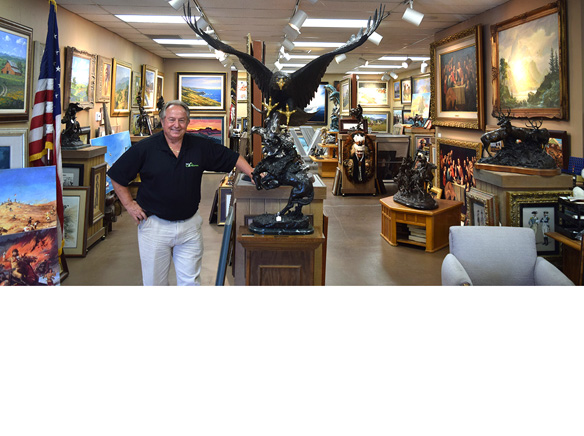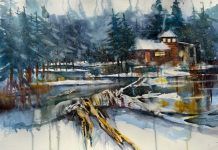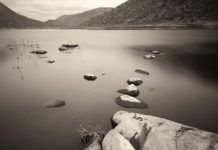When you walk into Art World Western Heritage Gallery it is overwhelming when you think about where to begin. From front to back, top to bottom the gallery is filled with one of a kind fine art collections, prints from the greatest Western artists, sculptures, and an impressive avant-garde collection. It is a museum of art history from all over the world and a collection that has taken owners Floyd Jones and his wife Helen 40 years to collect.
When you walk into Art World Western Heritage Gallery it is overwhelming when you think about where to begin. From front to back, top to bottom the gallery is filled with one of a kind fine art collections, prints from the greatest Western artists, sculptures, and an impressive avant-garde collection. It is a museum of art history from all over the world and a collection that has taken owners Floyd Jones and his wife Helen 40 years to collect. Art World has taken many directions over the years, survived the second largest depression in the United States and is now looking to continue its growth with its wide assortment of art.
“Now, we are trying to figure out how to kick start from where we are,” said Floyd Jones. “If you go around you will not find anything like what we have here in San Diego. We are now one of the best Western art galleries in the nation. Most of the others have closed their doors.”
Art World opened in 1976 after the Jones’ moved from Hawaii. They began in the art business in Hawaii and decided they wanted become the proprietors of a fine art gallery.
“We had gone to many of the Western art shows, so in 1979 we became Art World Western Heritage Gallery,” he said. “Before that we sold decorative art. Once we got into Western art we started looking for Western artists to work with. Olaf Wieghorst, Mark Martensen, Bud Bradshaw, Terry Redlin were just some of the artists we started working with, bringing them in one by one. Olaf was our big draw. He lived here in El Cajon and this was before the Olaf Wieghorst Museum and Western Heritage Center.”
Jones said his love of Western art came when he was doing a show in Texas, and an artist came in named Justice. He bought in his paintings, and people were buying them by the thousands and made a lot of money. But when the market went south and they were struggling when he got a call from Los Angeles asking him if he was interested in Wieghorst prints.
“At that time I didn’t know who he was,” he said. “She offered to sell them to me and within an hour I had sold them. She was the reason I started in Western art. After selling so many prints, she called me and said I should start buying them directly since I was selling them so fast. She helped me become a millionaire. We were selling 20 to 30 pieces a day.”
Art World began excelling at selling Wieghorst prints, and started the El Cajon Western Arts Festival at the East County Performing Arts Center where it would bring in 30 to 40 artists from all over the country. It was one of the top 10 Western art shows in America.
Jones said when Ronald Reagan was president, he loved Western art. There were a lot of Western movies, Olaf was in the movies, and his paintings were in the movies. Reagan bought Wieghorst’s art and his paintings went up in the hundreds of thousands.
“It was a big deal for El Cajon and for me,” he said. “We couldn’t get his original paintings, but we could get his prints. We’ve sold more than 15,000 of his prints. Selling those prints put our gallery on the map. We did our own artists and printed about 80,000 pieces and we still have around 35,000, so we have a lot of art.”
Jones then started his own publishing company, Art World Publication in 1985, and for 20 years published all of the artists that we worked with. They became the nucleolus of its publishing company. It had around 250 to 300 galleries around the country that bought fine art limited prints from them. But things changed fairly quickly for this mom and pop art gallery for several reasons.
Jones said in 2001, when 9/11 happened and it truly changed the course of this country. It changed the psychology of how people think and the format of how people buy. The art industry also started going through a transition when the Internet came. The Internet discovered that there was a customer base out there beyond anything anyone could think of. This Super Highway of Information made the art community vulnerable.
“Customers would come into your gallery, find artists that they liked, then go on the Internet and go directly to the artists’ website, bypassing the dealer. It became a huge problem,” he said. “We had 1,700 Western art galleries in the U.S. We had 300 fine art galleries. These were the backbone of the Western art world. Art dealers were cut out or cut back, and we became a museum for people to find art they wanted, but didn’t buy it from us. Artists could work directly with their consumers. But pretty soon, the artists devalued their own market by selling their art at such low prices. The dealer is the one that sales value and the artist sells art.”
Then came auctions. Jones said the auction industry was huge. The large auctions got smart and started doing around five shows a year, once again cutting out the dealer. Mom and Pop dealers started closing their doors.
“In 2008 the new president came in and psychologically upset this country to no end,” said Jones. “Free enterprise in this country took a huge hit. Another thing that came into play was the younger generation that stopped buying art. This generation that are now 25-30 do not buy big houses, do not by art, so there is that huge gap. The generation that bought a lot of Western art is now dying. So now, our gallery is also full of consignment art.”
Jones said that now, with a president that has an entrepreneur philosophy with an intention to restructure America again as a free enterprise country can put America in a position where individuals of any type can get a job, and open up a business. Cutting the tax rate in the country to 15 percent, businesses can hire people and hopefully do away with government regulations that destroy businesses.
“At one time, we had eight people working here, but little by little, we had to let them go,” he said. “Then we let our daughter go who had worked with us for 25 years. But we have helped a lot of people and helped ourselves too. When we look at the fun and joy that we have had in building this business in El Cajon, it means a lot to us. We don’t want to lose that, we don’t want to go out of the art business, so we are moving on and adding our golf company in the mix.
Jones said it is imperative to get rid of some of the government regulations in California. “It is a Democratic state and is intent on running businesses out of here. We are in a place that if we don’t get a kick in the pants, just a little bit, we can start getting a return,” he said.
Jones said the art world in this country is in a position where he believes it is going to take off again. But the art businesses need to figure out how to get to that younger generation.
“If we can talk about art as an investment, because fine art is an investment, the best selling artists are a guaranteed return,” he said. “We want people to come into our gallery. We have art for $25, for $100, $1,000 and higher investment art. We have many styles of art that are pleasing to everybody. We have hundreds on hundreds of images that we can work with for customers. We are a complete gallery. Custom framing, fine art, print, and we can give a customer a complete package. Right now, we have about 8,000 images of art that would normally cost you $800 to $1,000 that we can sell for $300 to $500. Less than half for consignment pieces that came to us within and outside the United States.”
Jones said Art World Western Heritage Gallery is one of the best art galleries in America.
“If you come to our gallery we will give you a wonderful, wonderful deal. We will save you money. We also have one of the best framing services in the country. The prices I use are the same that I used 25 years ago. You will get honesty and integrity at this gallery. We just tell you the truth,” he said.
Art World Western Heritage Gallery
1266 Broadway, El Cajon
www.artworldgalleries.com














